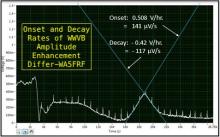Initial Observations From 14 October Annular Solar Eclipse
Initial Observations From 14 October Annular Solar Eclipse

HamSCI Announces Initial Observations From 14 October Annular Solar Eclipse—Encourages Amateur Participation in Upcoming 8 April 2024 Total Solar Eclipse QSO Party
Dr. Nathaniel Frissell W2NAF, Lead Organizer for HamSCI (The Ham Radio Science Citizen Investigation) and assistant professor of physics and engineering at The University of Scranton W3USR, has announced initial observations from the October 14th annular solar eclipse across North America.
“The October 14th celestial event has provided some very interesting early data for ionospheric research” Frissell noted in working with the HamSCI scientific team. “While we are only in the early stages of analysis and looking ahead to the total solar eclipse across much of North America on April 8th, we are encouraged that our planned experiments with data contributed largely by amateur radio operators will yield a wealth of new discoveries in the next year or so.”
Hundreds of amateurs participated in the HamSCI event by getting on the air. Combining their data with contacts from other amateur contest activities, citizen-science cooperation contributed to one of the largest participatory days ever in amateur radio history.
This project is studying the ionospheric response to the 2023 annular and 2024 total solar eclipse through a series of large-scale citizen science experiments known as the HamSCI Festivals of Eclipse Ionospheric Science (FoEIS), which includes the Solar Eclipse QSO Parties (SEQPs). The data for these experiments are generated by amateur radio operators communicating with each other over and around the eclipse paths using medium and high frequency signals that are refracted back to Earth by the ionosphere, and therefore sensitive to eclipse-induced ionospheric changes. These Festivals are coordinated by the Ham Radio Science Citizen Investigation (HamSCI) in collaboration with volunteers from across the amateur radio community.
The FoEIS consists of six primary components—The Solar Eclipse QSO Party (SEQP), the Grape High Frequency Doppler Experiment, WSPRdaemon observations, the Medium Wave AM Doppler Experiment, the High Frequency Time Difference of Arrival Experiment (TDOA), and the Very Low Frequency (VLF)/Low Frequency (LF) Experiments....
...Dr. Frissell noted that participation and early outcomes were very successful at this annular eclipse. He is anticipating that the support by the amateur community and the collaboration among scientists on April 8th during the total solar eclipse will be even greater.
HamSCI serves as a means for fostering collaboration between professional researchers and amateur radio operators. It assists in developing and maintaining standards and agreements between all people and organizations involved. Its goals are to advance scientific research and understanding through amateur radio activities and encourage the development of new technologies to support this research. October 14th was a perfect example of that collaboration, and many events were reported by clubs and individual hams. A short selection of photos from individual events is linked below.
The Monday, April 8th total solar eclipse will be the last in North America for nearly twenty years. HamSCI again encourages participation by amateurs to take part in the SEQP, the WSPR Challenge and the other scientific experiments to be conducted that day. Eclipse-specific information can be found at www.hamsci.org/eclipse.
The HamSCI Community is led by The University of Scranton Department of Physics and Engineering W3USR, in collaboration with Case Western Reserve University W8EDU, the University of Alabama, the New Jersey Institute of Technology Center for Solar Terrestrial Physics K2MFF, the MIT Haystack Observatory, TAPR in Arizona, additional collaborating universities and institutions, and volunteer members of the amateur radio and citizen science communities. We are grateful for the financial support of the United States National Science Foundation, NASA, and Amateur Radio Digital Communications (ARDC).
Pictures of the day’s activities across the country can be found here.
Full text of the release (5 pages), including images, is available here.
